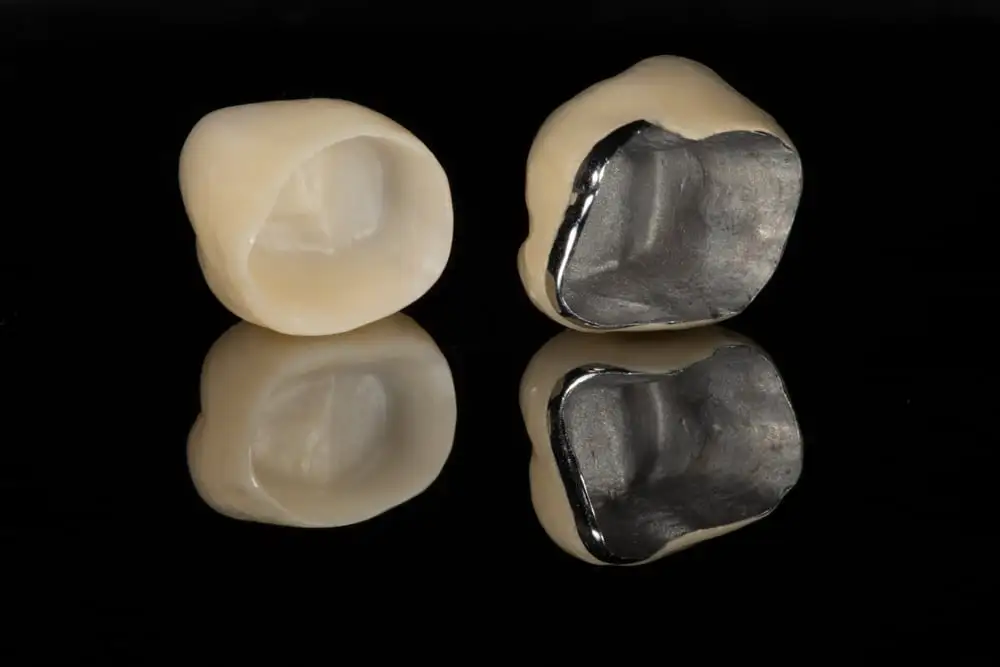
In restorative dentistry, dental crowns are primarily divided into two categories – porcelain and metal – each with unique characteristics. Porcelain crowns, with their natural tooth-like appearance, are considered ideal for front teeth. Metal crowns, on the other hand, with their exceptional strength and durability, are often recommended for back teeth that endure more pressure.
When comparing porcelain vs metal crowns, the differences extend beyond appearance – they also vary significantly in terms of strength, lifespan, comfort, and cost. While porcelain crowns are more attractive, they may be less resistant to heavy chewing forces. Metal crowns, despite their superior strength, have a noticeable metallic look that some patients might find aesthetically unappealing.
The decision between porcelain or metal crown depends on various factors like tooth location aesthetic preferences budget and your dentist’s recommendation which is why this article provides a comprehensive comparison of these two crown types including their pros and cons as well as selection criteria to help you make an informed decision while exploring how to make the best choice for both your dental health and smile.
What Are Porcelain Crowns?
All-ceramic crowns, also called porcelain crowns, are made from high-quality ceramic materials that mimic the transparency and light-reflecting properties of natural tooth enamel. At D’Amico Dental Care in Watertown and Wayland, we offer two main types of beautiful, durable crowns: traditional feldspathic porcelain and reinforced ceramics like zirconia or lithium disilicate. When considering porcelain vs metal crowns, all-porcelain options stand out for their completely metal-free construction, delivering the most natural-looking results – making them the top choice for front teeth where aesthetics matter most.

Key benefits and uses:
- Unmatched beauty: Perfect colour match with natural teeth
- Excellent tissue compatibility: Reduces gum irritation (no metal)
- Stain resistance: Maintains original colour for years
- Versatile applications: Ideal for front teeth and some back teeth cases
- Good lifespan: Lasts 10-15 years with proper care
All-porcelain crowns require more tooth preparation than metal crowns, and their strength might be slightly less for back teeth that endure heavy chewing forces. They’re also typically more expensive than other options.
What Are Metal Crowns?
Metal crowns are primarily made from alloys like gold, nickel-chromium, or cobalt-chromium, and are known as the most durable type of dental crown. They’re mainly used for back teeth that endure heavy chewing forces. Their standout feature is incredible strength and wear resistance, making them ideal for patients who grind their teeth or have powerful bites.
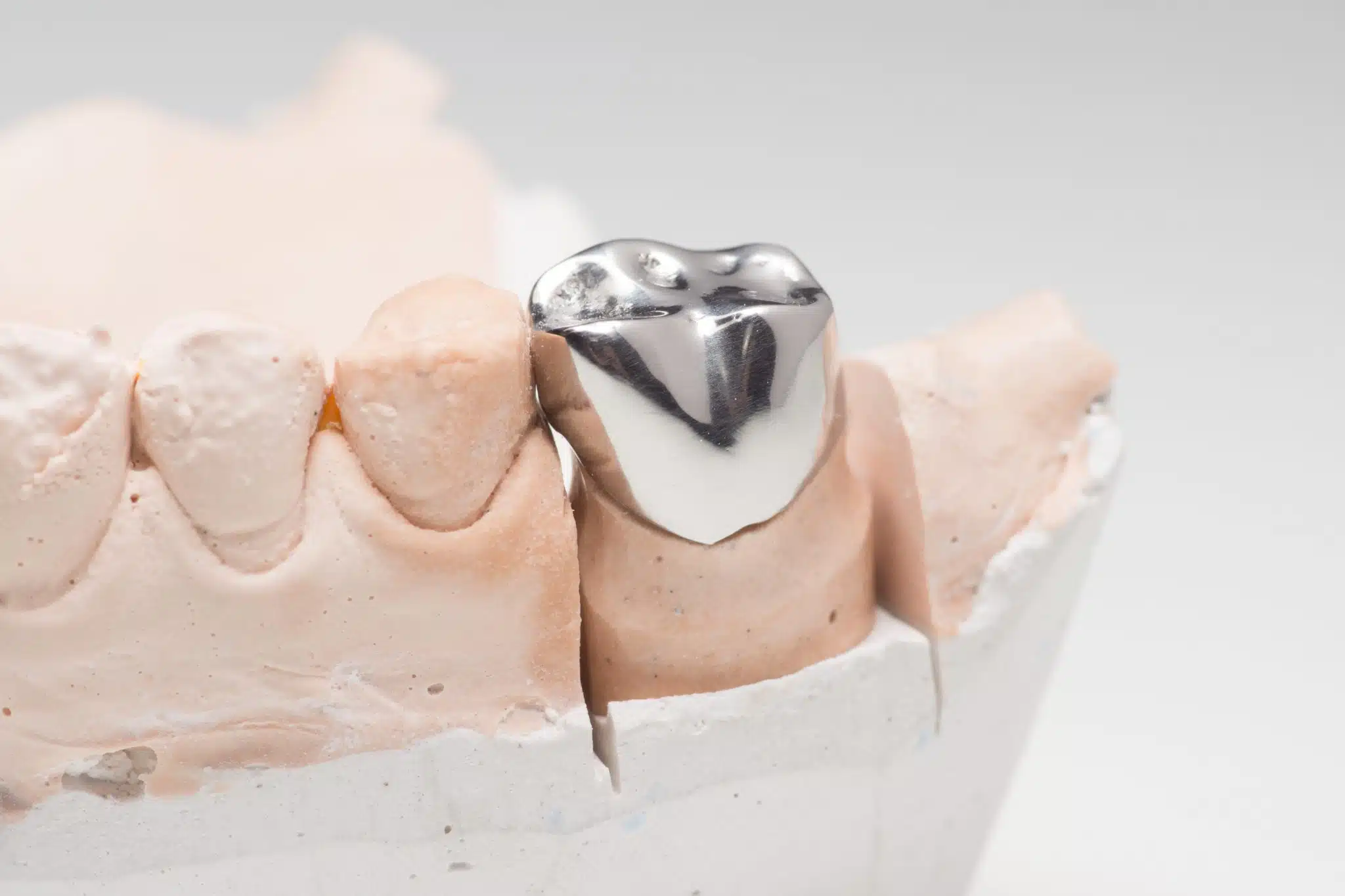
When comparing porcelain vs metal crowns, metal options shine in durability but have aesthetic limitations. Here are their key pros and cons:
Advantages:
- Extremely long lifespan (often 20-30+ years)
- Require less tooth removal than porcelain crowns
- High resistance to fractures and wear
- More affordable than all-porcelain crowns
Metal crowns have a few limitations, including a noticeable metallic look that makes them less ideal for front teeth, and some patients may have metal allergies. However, they’re a great choice for molars that are heavily damaged, especially for patients with a strong bite force. They’re also perfect when durability and strength are the top priorities, and they work well as a sturdy base for porcelain-fused-to-metal (PFM) crowns.
Key Differences Between Porcelain and Metal Crowns
Porcelain crowns offer a natural, tooth-like appearance and are primarily used for front teeth. Made from ceramic materials, they blend seamlessly with your surrounding teeth. However, when comparing porcelain vs metal crowns, porcelain options are less durable and may fracture under heavy pressure.
When considering a porcelain or metal crown it’s important to note that metal crowns are extremely strong and long-lasting making them ideal for back teeth that endure more chewing force as they’re crafted from gold or other metal alloys and can last for many years though their metallic appearance means they’re not suitable for visible front teeth which chooses between these two depend on the tooth’s location and your specific needs as we’ll now explore these differences in more detail.
Aesthetic Comparison: Natural Look vs. Metallic Finish
The fundamental difference between porcelain and metal crowns becomes evident when examining porcelain crowns which stand out with their unique characteristics offering the most natural appearance among all crown types thanks to their layered transparency and light-reflecting properties that mimic natural tooth enamel allowing them to blend perfectly with adjacent teeth while their precise color-matching ability and compatibility with natural tooth shades make them an ideal choice for front teeth combined with the absence of a metal margin that creates a more natural-looking gumline.
When considering porcelain vs metal crowns, metal options create an artificial look with their uniform metallic appearance. They lack the translucency and optical properties of natural teeth, often appearing as noticeable metal patches in the mouth. Even when using gold alloys, their appearance still differs significantly from natural teeth. This is why metal crowns are primarily used for back teeth that aren’t visible. That said, combining them with a ceramic layer (PFM) can sometimes improve their appearance.
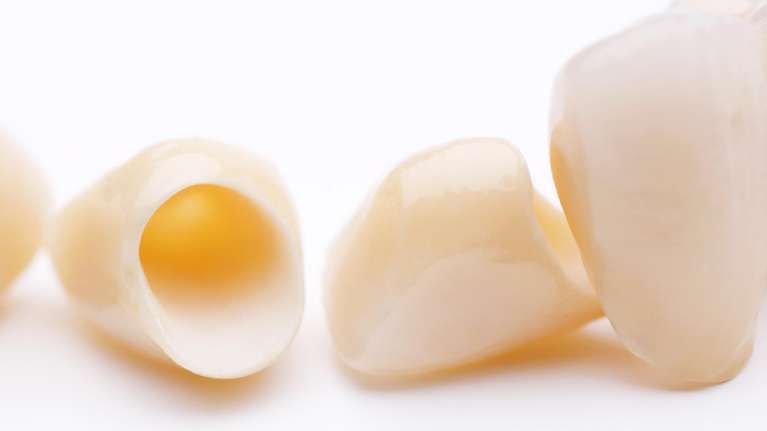
Strength and Durability: Which Crown Lasts Longer?
Metal crowns have a clear advantage when it comes to strength and durability. Their solid metal structure makes them incredibly resistant to chewing forces, rarely fracturing even under pressure. Typically lasting 20 to 30 years (and sometimes even longer), metal crowns are the go-to choice for back teeth that endure heavy chewing.
When comparing porcelain vs metal crowns, porcelain options (especially traditional types) are less durable and more prone to fractures. They usually last about 10 to 15 years, though advanced zirconia ceramics come close to matching metal’s strength. One important difference: chipped porcelain crowns often need complete replacement, while metal crowns rarely require replacement at all.
Comfort and Fit: Porcelain vs. Metal Crowns
At D’Amico Dental Care in Watertown and Wayland, our porcelain crowns are designed to feel completely natural in your mouth—many patients say they forget they even have one! Unlike metal-based crowns, they eliminate temperature sensitivity and won’t irritate your gums thanks to their smooth, metal-free edges. They’re also lightweight and custom-fitted to your tooth, which means easier adjustment and better protection against bacteria. Whether you’re chewing, smiling, or just going about your day, you’ll appreciate how seamlessly they blend with your natural teeth.
When considering porcelain vs metal crowns, metal options may cause some discomfort despite their superior strength. Their high thermal conductivity can make teeth more sensitive to hot and cold. While their thinner design (requiring less tooth removal) might feel more comfortable to some patients, there’s a small chance of allergic reactions to the metal alloys. Though metal crowns initially fit well, gum recession over time might eventually expose the metal edge.
Choosing between these crowns depends on your priorities (comfort vs. strength) and the tooth’s location. Your dentist can help determine which option works best for you.
Cost Comparison: Porcelain vs. Metal Crowns
The key difference between porcelain and metal crowns becomes apparent when examining costs as porcelain crowns typically cost more than metal ones with prices varying depending on the material used (regular porcelain zirconia or lithium disilicate) and your dentist’s expertise since generally all-porcelain crowns are about 30-50% more expensive than metal crowns which reflects the quality materials more complex lab fabrication process and additional skill required for placement. At the same time, they have a higher upfront cost, porcelain crowns might prove more cost-effective long-term as they often require fewer replacements.
When comparing porcelain vs metal crowns, metal options – especially basic ones like nickel-chromium – are typically the most budget-friendly. Gold crowns, despite the precious metal cost, can be more economical over time due to their exceptional longevity. The lower price of metal crowns comes from simpler manufacturing processes, less expensive materials, and requiring less tooth preparation. However, potential costs from aesthetic concerns or metal allergies might offset these initial savings in some cases.
The exact price depends on multiple factors like your location, the dentist’s experience, and your specific dental needs. Many dental insurance plans provide better coverage for metal crowns than porcelain ones.
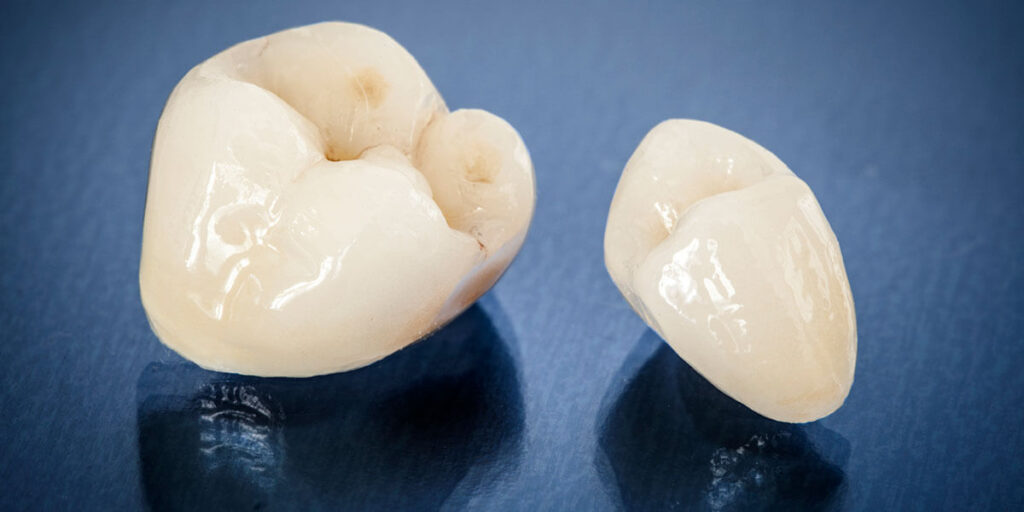
Best Uses for Porcelain Crowns
Porcelain crowns are the ideal choice for front teeth thanks to their natural appearance and aesthetic appeal. They’re perfect for anyone looking to enhance their smile. Whether it’s for teeth that are severely discoloured and resistant to whitening, chipped or cracked teeth, or teeth with irregular shapes, all-porcelain crowns deliver beautiful results. They’re also the best option for patients with metal allergies.
When considering porcelain vs metal crowns, porcelain options (especially zirconia) work well for teeth that need both beauty and function, like canines or premolars. They’re widely used in Hollywood smile makeovers, too. That said, for large molars that endure heavy chewing forces, metal or PFM crowns are usually recommended – unless you opt for reinforced ceramics like zirconia.
“ Survival rates of most types of all-ceramic SCs were similar to those reported for metal-ceramic SCs, both in anterior and posterior regions. Weaker feldspathic/silica-based ceramics should be limited to applications in the anterior region. Zirconia-based SCs should not be considered as the primary option due to their high incidence of technical problems. “
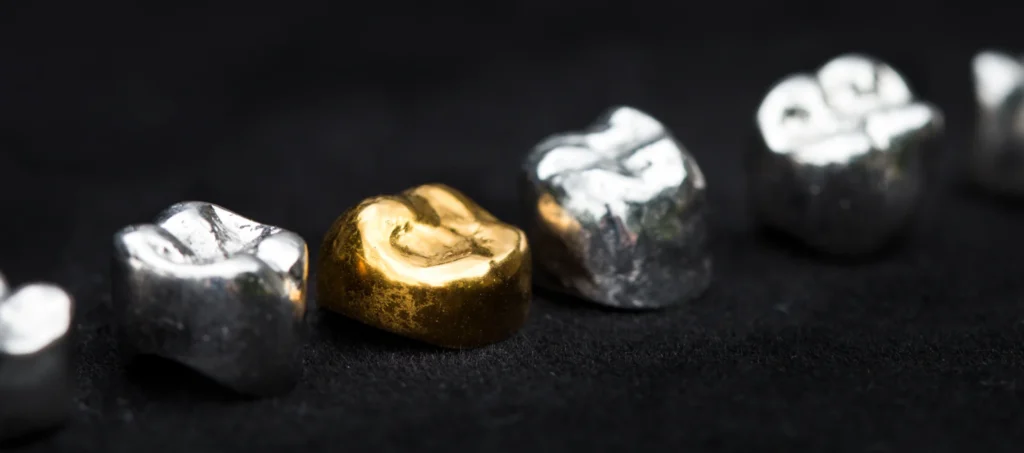
Best Uses for Metal Crowns
The critical difference between porcelain and metal crowns lies in their durability and clinical applications as metal crowns are the most durable option making them the best choice for back teeth since they’re particularly ideal for large molars that endure heavy chewing forces whether for extensively damaged teeth post-root canal treatment or patients who grind their teeth as metal crowns excel in these situations while also being great when there’s limited space between teeth and minimal tooth reduction is needed.
When considering porcelain vs metal crowns, gold crowns stand out as the gold standard in restorative dentistry for patients seeking exceptional longevity. They’re perfect for long-term bridge supports and patients with strong bite forces. Of course, their metallic appearance means they’re typically used only for non-visible teeth. Where strength and durability are top priorities, metal crowns can last 30 years or more!
How to Choose Between Porcelain and Metal Crowns
At D’Amico Dental Care in Watertown and Wayland, we’ll help you choose between porcelain and metal crowns based on what’s best for your unique smile. The choice between porcelain or metal crown primarily depends on tooth position as for visible front teeth where appearance matters most porcelain crowns are preferable while metal crowns work better for molars that endure heavy chewing though the tooth’s condition also plays a role since extensively damaged or root canal-treated teeth typically need stronger crowns and patient expectations regarding aesthetics budget and desired longevity further influence the final decision.
Key considerations when choosing:
- Aesthetics: Porcelain for visible teeth
- Strength: Metal for back teeth with heavy chewing pressure
- Sensitivity: Porcelain for metal allergy sufferers
- Cost: Metal crowns are typically more affordable
- Longevity: Metal crowns last longer
When weighing porcelain vs metal crowns, PFM crowns (porcelain-fused-to-metal) often provide a good balance between beauty and durability in many cases. Consulting with a prosthodontist can help determine the best option for your specific needs.
FAQ
1. How are porcelain and metal crowns made?
Porcelain crowns are crafted from high-quality dental ceramic that closely mimics natural tooth appearance. These crowns are designed and manufactured in specialized laboratories. In contrast, metal crowns are typically made from gold alloys, nickel, or chromium, offering exceptional strength, but their metallic appearance makes them unsuitable for front teeth.
2. Which type provides a more natural appearance?
Porcelain crowns offer superior colour matching and translucency, perfectly resembling natural teeth – making them ideal for front teeth. Metal crowns have a metallic look and are generally only used for posterior (non-visible) teeth. However, there’s a metal crown variant coated with porcelain (PFM) that offers better aesthetics.
3. Which type lasts longer?
Metal crowns demonstrate exceptional resistance to chewing forces due to their inherent metallic strength, typically lasting 15-30 years. Porcelain crowns are also durable but may crack under extreme pressure. The latest ceramic crowns (e.g., zirconia) approach metal-like durability.
4. Which type has better body compatibility?
Porcelain crowns are fully biocompatible with oral environments and rarely cause allergic reactions. Metal crowns may trigger sensitivities in some patients, particularly those containing nickel alloys. Gold crowns cause the least allergic reactions but are significantly more expensive.
5. How much tooth reduction is required for each?
Porcelain crowns generally require more tooth reduction due to their greater thickness needed for adequate strength. Metal crowns can be made thinner thanks to their inherent strength, preserving more natural tooth structure – a crucial factor in dental conservation.
6. What’s the price difference between these crowns?
Porcelain crowns are typically more expensive than metal crowns, especially advanced types like zirconia. Standard metal crowns (non-gold) are the most economical option. Gold crowns are the priciest metal variant. Porcelain crowns may cost 2-3 times more than standard metal crowns.
7. What are their ideal uses?
Porcelain crowns are best for visible front teeth where aesthetics matter most. Metal crowns suit posterior teeth, enduring heavy chewing forces. For bruxism (teeth grinding) cases or when extreme durability is needed, dentists may recommend metal crowns.
8. How to choose between porcelain and metal crowns?
The choice depends on multiple factors: tooth position, aesthetic importance, budget, overall oral health, and the dentist’s recommendation. For professional advice, dentists evaluate all these aspects. Today, zirconia crowns – combining porcelain’s beauty with metal’s strength – have become a popular compromise.

